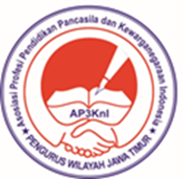ENRICHING VOCABULARY MASTERY USING SHORT STORIES (A Classroom Action Research in the Second Year of SMP N 5 Sukoharjo in the Academic Year of 2009/2010)
DOI:
https://doi.org/10.24269/dpp.v3i1.140Abstract
This study is based on the problems of the low vocabulary mastery of the second year students of SMP N 5 Sukoharjo in the academic year of 2009/2010. It focuses on knowing whether using short stories can enrich the students’ vocabulary. It also focuses on the improvement of the students’ achievement in teaching learning process using short stories.
The materials implemented in this research were short stories. The procedure of the research consisted of identifying the problems, planning the action, implementing the action, observing or monitoring the action, reflecting the result of the observation, and research findings. The research was conducted in a cycle. The cycle consisted of four meetings. Techniques in collecting the data were qualitative and quantitative method. In the qualitative method, the researcher used observations, field notes, photographs, and document analysis. The results of the observation were in the form of field notes and photographs. In the quantitative method, the researcher used tests. The test consisted of the pre-test and post-test. The technique to analyze the test result was by comparing the mean score of pre-test and post-test. Besides that, this research also used descriptive statistics and the t-test of non-independent.
The results of this research show that short stories can improve the students’ vocabulary mastery. The improvement can be seen in the form of students’ achievements. They can be seen from the aspects of vocabulary mastery and the students’ motivation. First, from the aspect of the vocabulary mastery, the students could understand, grasp, remember, pronounce, write about 75 until 80 % of the words correctly and also use the words in context appropriately. Then, the improvement of students’ score can be seen from the differences between the pre-test and post-test. The mean score of the pre-test improves from 4.07 to 7.36 in post-test. Then, the scores of the pre-test and post-test show that there is also an improvement of students who achieve the minimum standard score, that is 60. They are from 2.8% to 94.3% of students. The test result shows that there is a significant improvement of the students’ vocabulary after the researcher conducted the research. The difference between the pre-test and post-test scores is 3.30; while the coefficient of the t-test between the pre-test and post-test is 19.29. Meanwhile, the t-table
for 35 students is 2.04. Since
is higher than
, it means that there is a significant difference between pre-test and post-test score. Second, from the students’ motivation, the students are more active and enthusiastic during teaching learning process. Next, they have more concentration to do the exercises. Then, they do not do something useless during teaching learning process. At last, they also like having discussion with their friends.
Downloads
Published
Issue
Section
License
Copyright
Authors who publish their manuscripts in this journal agree to the following terms:
- The copyright on each article belongs to the author.
- The author acknowledges that Jurnal Dimensi Pendidikan dan Pembelajaran has the right to be the first to publish under a Creative Commons Attribution 4.0 International (Attribution 4.0 International CC BY 4.0) license.
- Authors may submit articles separately, arranging for the non-exclusive distribution of manuscripts that have been published in this journal to other versions (e.g., sent to the author's institutional repository, publication into books, etc.), acknowledging that the manuscript was first published in the Jurnal Dimensi Pendidikan dan Pembelajaran.
Â
License
Use of the article will be governed by the Creative Commons Attribution license as currently published under the Creative Commons Attribution 4.0 International License (Attribution 4.0 International (CC BY 4.0).
Â
This license permits anyone to copy and redistribute this material in any form or format, compose, modify, and make derivatives of this material for any purpose, including commercial purposes, as long as they give credit to the author for the original work.


_001.jpg)



